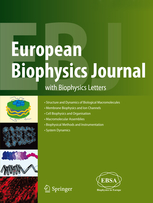VEGA 2/0147/14
Development of dyadic calcium signaling during postnatal maturation of ventricular myocytes
Principal Investigator: Ivan ZahradníkDuration: January 2014 – December 2016
|
Annotation:Cardiac muscle of new-borns develops in concert with the development of physical activity. In cardiac myocytes, the volume of contractile myofibrils, of inner membrane system and of mitochondria increases. Circulation of calcium ions during the contraction-relaxation cycle becomes progressively internalized, and the dyadic system that serves for excitation-contraction coupling by means of calcium signalling expands. The objective of the project is to characterize the development of calcium release and of ultrastructure of the dyads during postnatal development of rat myocardium. Original data on the development of calcium signalling, acquired in isolated cardiac myocytes by laser scanning confocal microscopy combined with the patch clamp method, will be correlated with data on development of dyadic ultrastructure acquired by means of electron microscopy. The results will aid clarification of calcium signalling in the cardiomyocytes of neonatal heart. |
Keywords:Myocardium, ontogenesis, calcium signaling, excitation-contraction coupling, confocal microscopy, electrophysiology |
Objectives:Organization and function of excitation-contraction coupling units (dyads) of cardiac myocytes in the new-borns is at the periphery of basic research, although it is generally known that the myocytes of the postnatal myocardium undergo rapid development. The dyads form postnatally and they develop in parallel to the increased demands for pumping function of the myocardium. The objective of this project is to characterize the development of dyad functionality from the viewpoint of calcium signalling upon transformation of the myocytes from the embryonic to the terminally differentiated form during maturation of the myocardium. We will utilize our original know-how for characterization of calcium signals. Understanding the development of structure and function of the dyads will enable a better understanding of the functional specifics of developing myocardium of new-borns and of pharmacotherapy of children. We expect that the new findings will also allow better understanding of the basic adaptation mechanisms of adult myocardium to pathological stress, during which at the level of myocytes hypertrophic mechanisms typical for neonatal myocytes are activated. |
Publications: |
 |
Hotka M, Zahradnik I (2017): Reconstruction of membrane current by deconvolution and its application to membrane capacitance measurements in cardiac myocytes. PLoS One 12: e0188452. |
 |
Mackova K, Zahradnikova A Jr, Hotka M, Hoffmannova B, Zahradnik I, Zahradnikova A (2017). Calcium release-dependent inactivation precedes formation of the tubular system in developing rat cardiac myocytes. Eur Biophys J 46: 691-703. |
 |
Hotka M, Zahradnik I (2014): Correction of the cross-talk error in cell membrane impedance analysis. In: YBERC 2014. Bratislava, Slovak Republic. Proceedings of The 6th International Young Biomedical Engineers and Researchers Conference, July 2-4, 2014, p. 31-34. ISBN 978–80–971697–0–1. |
| Hotka M, Zahradnik I (2014): High resolution measurement of electrical impedance of excitable cells. In: Adept 2014. 2nd International Conference on Advances in Electronic and Photonic Technologies, Tatranská Lomnica, June 1-4, 2014, Proceedings of Adept, p. 55-58. | |
 |
Novotova M, Tarabova B, Tylkova L, Ventura-Clapier R, Zahradnik I (2016): Ultrastructural remodelling of slow skeletal muscle fibres in creatine kinase deficient mice: a quantitative study. Gen Physiol Biophys 35: 477–486. |

 contact
contact
